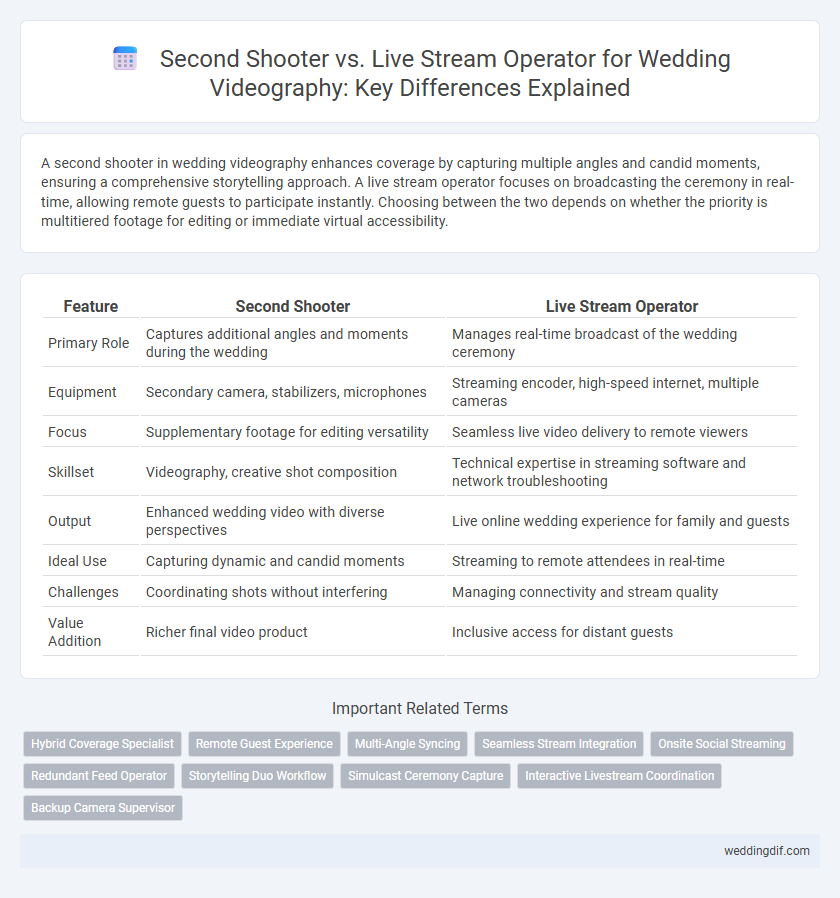A second shooter in wedding videography enhances coverage by capturing multiple angles and candid moments, ensuring a comprehensive storytelling approach. A live stream operator focuses on broadcasting the ceremony in real-time, allowing remote guests to participate instantly. Choosing between the two depends on whether the priority is multitiered footage for editing or immediate virtual accessibility.
Table of Comparison
| Feature | Second Shooter | Live Stream Operator |
|---|---|---|
| Primary Role | Captures additional angles and moments during the wedding | Manages real-time broadcast of the wedding ceremony |
| Equipment | Secondary camera, stabilizers, microphones | Streaming encoder, high-speed internet, multiple cameras |
| Focus | Supplementary footage for editing versatility | Seamless live video delivery to remote viewers |
| Skillset | Videography, creative shot composition | Technical expertise in streaming software and network troubleshooting |
| Output | Enhanced wedding video with diverse perspectives | Live online wedding experience for family and guests |
| Ideal Use | Capturing dynamic and candid moments | Streaming to remote attendees in real-time |
| Challenges | Coordinating shots without interfering | Managing connectivity and stream quality |
| Value Addition | Richer final video product | Inclusive access for distant guests |
Understanding the Roles: Second Shooter vs Live Stream Operator
The second shooter in wedding videography captures supplementary angles and candid moments, enhancing the storytelling with varied perspectives. The live stream operator manages real-time broadcasting, ensuring seamless connectivity and quality for remote viewers during the event. Each role demands distinct skills: the second shooter excels in creative camerawork, while the live stream operator focuses on technical setup and live audio-visual management.
Key Responsibilities of a Wedding Second Shooter
A wedding second shooter captures complementary angles and candid moments that the primary videographer may miss, ensuring comprehensive coverage of the event. Their key responsibilities include filming guest reactions, detail shots such as decor and rings, and assisting with lighting or equipment setup. This role enhances the overall wedding video by providing diverse perspectives and supporting the lead operator's workflow.
What Does a Live Stream Operator Do at Weddings?
A live stream operator at weddings manages real-time video broadcasting, ensuring seamless coverage and high-quality streaming to remote viewers. They coordinate camera angles, switch between shots, and adjust audio levels to capture the ceremony and key moments as they happen. Unlike a second shooter who primarily focuses on capturing additional footage for later editing, the live stream operator prioritizes immediate transmission and viewer experience.
Pros and Cons of Hiring a Second Shooter
Hiring a second shooter for weddings enhances coverage by capturing multiple angles and spontaneous moments, increasing the variety and depth of footage. However, it can raise costs and require careful coordination to ensure consistent style and communication between shooters. Unlike a live stream operator focused solely on broadcasting the event in real-time, a second shooter contributes more creatively to the final edited product.
Live Streaming Benefits for Modern Wedding Ceremonies
Live stream operators enable real-time broadcasting of wedding ceremonies, allowing distant guests to participate instantly, enhancing inclusivity and emotional connection. Unlike second shooters who focus on capturing additional angles for post-production, live stream operators focus on seamless tech integration to ensure uninterrupted, high-quality video and audio feeds. This approach supports modern weddings by expanding audience reach and preserving the event in a shareable digital format.
Enhancing Wedding Videos: How a Second Shooter Adds Value
A second shooter captures diverse angles and candid moments that the primary videographer may miss, enriching the storytelling of a wedding video. Their presence ensures continuous coverage during key events like vows and reactions, creating a more dynamic and emotionally engaging final product. This multidimensional footage enhances the overall quality and depth, making the wedding video a comprehensive and memorable keepsake.
Technical Requirements: Second Shooter vs Live Stream Operator
A second shooter in wedding videography requires proficiency in multiple camera setups, advanced framing techniques, and seamless coordination with the primary videographer to capture diverse angles and moments. In contrast, a live stream operator must excel in real-time video encoding, managing streaming software, stable internet connectivity, and handling live audio mixing to ensure smooth, uninterrupted broadcasts. Both roles demand specialized technical skills, but while second shooters focus on creative shot composition, live stream operators prioritize reliable transmission and viewer experience.
Cost Comparison: Budgeting for Additional Wedding Videography Staff
Hiring a second shooter for wedding videography typically costs between $500 and $1,500, depending on experience and location, while live stream operators charge around $300 to $800 per event due to specialized equipment needs. Budgeting for additional staff requires considering equipment rental fees, travel expenses, and post-production time, which tend to be higher for live stream operators. Couples should evaluate the value of enhanced coverage from a second shooter versus the technical demands and real-time delivery benefits offered by a live stream operator when planning their wedding videography budget.
Deciding What’s Best: Second Shooter or Live Stream Operator?
Choosing between a second shooter and a live stream operator depends on the couple's priorities: capturing multiple angles and candid moments versus broadcasting the ceremony in real time to distant guests. A second shooter enhances the final wedding video with dynamic coverage and behind-the-scenes shots, while a live stream operator ensures seamless, professional-quality streaming with minimal technical issues. Assessing the guest list, budget, and desired wedding experience helps determine which role adds the most value to the event.
Ensuring Memorable Moments: Choosing the Right Option for Your Wedding
A second shooter captures diverse angles and candid moments, enhancing the storytelling of your wedding day with professional videography expertise. A live stream operator focuses on broadcasting the event in real-time, allowing remote guests to participate and experience the ceremony as it happens. Selecting between a second shooter and a live stream operator depends on your priorities for preserving memories or sharing your wedding live with distant friends and family.
Second Shooter vs Live Stream Operator for weddings. Infographic

 weddingdif.com
weddingdif.com